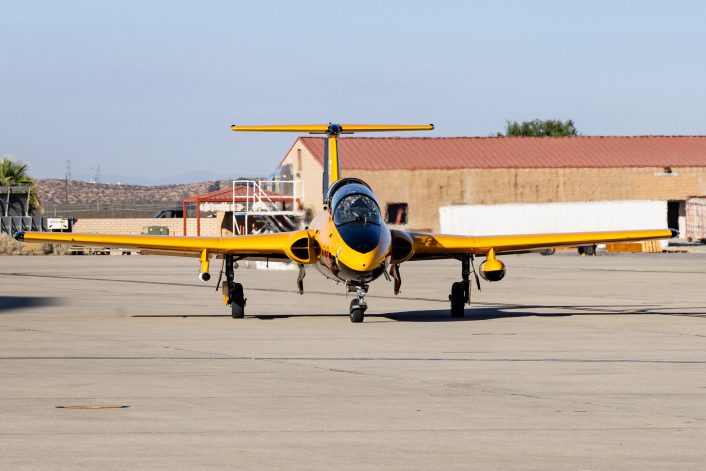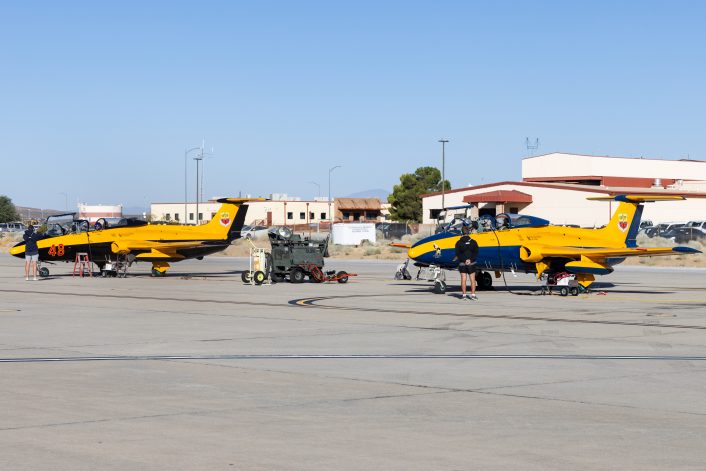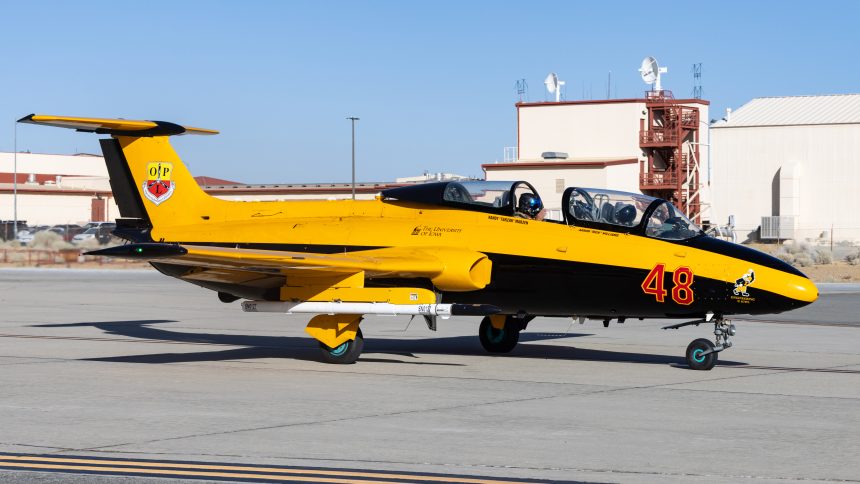Despite being nearly 60 years old, the two L-29 jets were critical to advancing the student curriculum and gathering vital data for ongoing research in machine learning and autonomy.
The United States Air Force Test Pilot School (USAF TPS) recently collaborated with the University of Iowa’s College of Engineering Operator Performance Laboratory (OPL) in deploying two highly modified L-29 jets to Edwards Air Force Base (AFB), California. The deployment provided students in class 24A with invaluable hands-on experience, reinforcing the USAF TPS’s role in producing the next generation of flight test leaders. The two aircraft, nearly 60 years old, were critical also in gathering vital data for ongoing research in machine learning and autonomy.
The Operator Performance Laboratory (OPL) is a globally recognized research facility specializing in flight testing, focusing on human-in-the-loop systems and intelligent autonomous technologies to enhance operational efficiency, safety, and system interoperability. With 24 years of experience, OPL has accumulated over 2,800 flight test hours across more than 400 projects or incremental tasks. The lab boasts extensive resources, including 11 instrumented aircraft (six manned and five unmanned) and six flight simulators. OPL’s research areas of interest include advanced flight deck design, airborne sensor integration, UAV systems, and automotive user interfaces, making it a versatile and crucial player in advancing aerospace and autonomous systems research.
Modernizing the Curriculum with Vintage Aircraft
The L-29 Delfin jets, originally designed in the late 1950s (the first flight of the type dates back to Apr. 5, 1959), have undergone significant modifications to serve modern testing needs. Equipped with advanced displays, experimental datalinks, and a range of sensors, these aircraft act as flying laboratories capable of rapid data acquisition and analysis. The jets’ ability to collect vast amounts of real-time data makes them invaluable for the USAF TPS’s goal of integrating cutting-edge technologies into its curriculum.

During this deployment, students were exposed to advanced human systems integration techniques, such as “Rhino Pointing,” a specialized helmet-tracking technology, as well as fifth-generation haptics, allowing them to interact with touchscreen large-area displays. These systems prepare students to handle the complexities of modern aircraft, emphasizing the role of human-machine interaction in future aerial combat.
By offering students hands-on throttle and stick control, the L-29 aircraft enabled them to become familiar with the kind of precise, mission-critical flying required of modern test pilots. Despite their age, these aircraft serve as a bridge between the old and the new, demonstrating that legacy platforms can still play a pivotal role in training for the future.
Supporting Research and Autonomy Development
One of the primary objectives of the deployment was to support a Test Pilot School research project known as “Have Fortitude.” This project focuses on developing trust in autonomy, an essential component for the Department of Defense (DoD) as it moves toward integrating artificial intelligence (AI) into combat systems. The L-29 aircraft were instrumental in this effort, serving as test beds for gathering data during simulated air-to-air engagements over Edwards AFB airspace.
The high-resolution imagery captured by the jets’ onboard cameras during these simulated engagements will play a crucial role in furthering the Defense Advanced Research Projects Agency’s (DARPA) Air Combat Evolution (ACE) program. This program aims to merge AI with combat aircraft, creating a future where pilots can rely on intelligent systems for tactical decision-making. By contributing to this research, the L-29 deployment supports broader efforts to develop AI-driven systems that could one day revolutionize aerial combat.
Maj. Kyle Smith, an experimental test pilot and PhD student at the University of Iowa, highlighted the significance of this collaboration in a public release: “It was fantastic to be a part of the inaugural deployment of Operator Performance Laboratory assets to Edwards,” he remarked. “Not only did we collect meaningful data for several research efforts, but we also exposed future test leaders to critical technology and concepts that are increasingly relevant in today’s environment.”
A Collaborative Partnership for the Future
The ongoing collaboration between USAF TPS and the University of Iowa’s Operator Performance Laboratory is not just about aircraft and research; it is also about developing future leaders. Instructors at USAF TPS are encouraged to obtain advanced degrees before returning to the school to educate the next generation of test pilots. This collaboration began in 2020, when instructors and graduates started using the L-29 aircraft as additional test beds for AI research and development. The current deployment represents the next phase in this long-term relationship.
Wei Lee, a senior instructor at USAF TPS, praised the partnership, noting that it allowed the school to achieve several objectives in a single deployment. “Within a single deployment, we provided students with a unique qualitative evaluation flight, broadened our staff experience, and supported DARPA through flight test expertise,” Lee said. “All of this concurrently benefited current research for our PhD candidates at the Operator Performance Laboratory.”
This integration of academic research and military training underscores the USAF TPS‘s commitment to pushing the boundaries of aerospace innovation. By partnering with institutions like the University of Iowa, the school is able to incorporate the latest technologies into its curriculum, ensuring that its students are prepared to meet the challenges of modern aerospace warfare.
Edwards Air Force Base: The Ideal Training Ground
Located at the edge of the Mojave Desert in Southern California, Edwards AFB provides the perfect environment for flight testing. Its clear weather nearly year-round and access to vast airspace make it an ideal location for conducting the kind of high-risk, high-reward flight tests that are essential to developing new aircraft systems. The deployment of the L-29 jets to Edwards AFB reflects the base’s continuing role as a hub for cutting-edge aerospace research and training.
The U.S. Air Force Test Pilot School serves as the Air Force’s premier institution for advanced flight training, preparing experimental test pilots, engineers, and navigators to conduct evaluations of new aerospace weapons systems and other military aircraft. Originally founded on September 9, 1944, as the Flight Test Training Unit at Wright-Patterson Air Force Base in Dayton, Ohio, the school relocated on February 4, 1951, to Edwards Air Force Base in Southern California.
Since its inception, the USAF TPS has produced some of the U.S. Air Force and allied air forces’ most influential leaders, including World War II aces, astronauts, and pioneers in aviation. The school’s alumni continue to shape the future of flight testing and innovation, with over 3,260 graduates, including more than 325 international graduates from 24 countries. The school’s motto, “Knowledge is Power,” reflects its mission to continuously adapt its curriculum to meet the evolving demands of aerospace technology.
From its early days providing astronaut training during the space race to its current focus on integrating AI into aircraft systems, the USAF TPS remains at the forefront of flight test education. The L-29 deployment is the latest example of how the school is modernizing its approach to ensure that its graduates are equipped to lead the future of aerial warfare.










